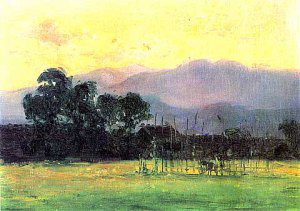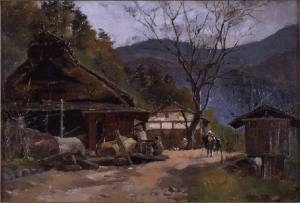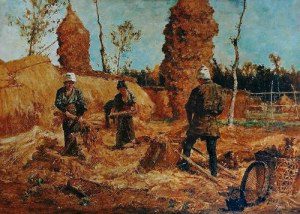Art of Japan and Asai Chu: The altered artistic landscape
Lee Jay Walker
Modern Tokyo Times

The Meiji Restoration of 1868 led to many social convulsions and like all revolutionary periods you had many winners and losers. This applies to individuals who could adapt to the rapid changes in society. Hence, the art world was no exception because new ideas were altering the artistic landscape. Asai Chu (1856-1907) belonged to this changing world. However, in some ways, he was lucky because he was young enough to understand these momentous events in Japanese history.
The old world of ukiyo-e became eclipsed in the lifetime of Asai Chu despite some amazing Meiji ukiyo-e artists. Not surprisingly, Asai Chu became involved in the new wave of Japanese art that was heavily influenced by Western-style artists. Of course, it wasn’t a one-way street because some Western artists including Van Gogh, Paul Gauguin, Claude Monet, Edgar Degas, James Abbott McNeill Whistler, Mary Cassatt, Henri de Toulouse-Lautrec, and others, adored aspects of ukiyo-e.
However, the technological developments of photography and other areas meant that ukiyo-e could not compete on a level playing field based on the reality of modernization. Also, different cultural influences and Japanese artists living abroad meant that new dynamics were at work. This implies that while technological change increased the artistic transition, the old order would have been usurped anyway based on cultural interaction and changing thought patterns. Therefore, for individuals like Asai Chu, these were exciting times.

Ironically, the Meiji period did witness many fantastic ukiyo-e artists and it is because of these individuals that it managed to cling on for so long. Notable Meiji ukiyo-e artists include Yoshitoshi, Chikanobu, Kobayashi Kiyochika, Ogata Gekko, Kawanabe Kyosai, Toyohara Kunichika, Utagawa Yoshifuji, Mizuno Toshikata, Ginko Adachi, and several others. However, they were swimming “against the tide” despite their collective skills.
Traces of the old world survived in modern Japan through new movements like shin-hanga. Yet, this area was limited when compared with the days of Hokusai, Hiroshige, Utamaro, and many other amazing artists who belong to the world of ukiyo-e. However, this isn’t to underestimate the shin-hanga movement because it produced many stunning artists like Ito Shinsui, Hiroshi Yoshida, and Kawase Hasui (to name just a few). Also, the bridge of the shin-hanga movement meant that “the shadow” of the old world was ticking but fused with new changes and thinking within this intriguing art form.
Asai Chu blossomed under Kunisawa Shinkuro and he was also lucky enough to study under Antonio Fontanesi. The reason why he had this opportunity was based on the Meiji elites who wanted to transport the best of the Western world and fuse this with the best of Japan. Therefore, in the area of science, the arts, law, industrialization, military thinking, commerce, political systems, and so forth, the power of the West became embodied within the psyche of the new Japan. Of course, while new thought patterns emerged, the power of Japanese culture and different thought patterns meant that you had many fusions. Hence, in certain areas “a new way” emerged based on Japanization.

In an earlier article, I state, “The Meiji government hired Antonio Fontanesi in order that he would introduce oil painting from Europe and clearly Asai Chu learned much because his passion and sophistication grew. When Asai Chu was in his forties he resigned from being a professor in Tokyo and moved to France for two years. This decision was wise because by studying at an impressionist art school he managed to enhance his artistic skill and techniques.”
The inquisitive nature of Asai Chu and his love of art meant that France would enhance him personally. In turn, he would influence many important Japanese artists when he returned home. This must have pleased the Meiji leaders who were involved in the arts.

Therefore, artists like Yasui Sotaro, Suda Kunitaro, Umehara Ryuzaburo, and others, learned many things from Asai Chu. On returning to Japan he became a professor at Kyoto College of Arts and Crafts. Also, he became involved in many clubs related to art.
Ukiyo-e was clearly on “borrowed time” because of the prevailing conditions. Hence, artists like Asai Chu re-invigorated Japanese art during this dynamic period in Japanese history. The shin-hanga movement meant that the power of ukiyo-e was kept alive for many decades throughout the twentieth century because of artists like Asai Chu.
Modern Tokyo News is part of the Modern Tokyo Times group
DONATIONS to SUPPORT MODERN TOKYO TIMES – please pay PayPal and DONATE to sawakoart@gmail.com
http://moderntokyotimes.com Modern Tokyo Times – International News and Japan News
http://sawakoart.com – Sawako Utsumi personal website and Modern Tokyo Times artist
https://moderntokyonews.com Modern Tokyo News – Tokyo News and International News
http://global-security-news.com Global Security News – Geopolitics and Terrorism
PLEASE JOIN ON TWITTER
https://twitter.com/MTT_News Modern Tokyo Times
PLEASE JOIN ON FACEBOOK
